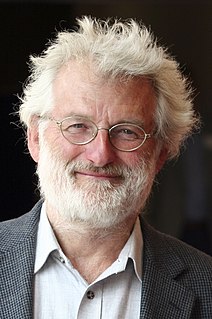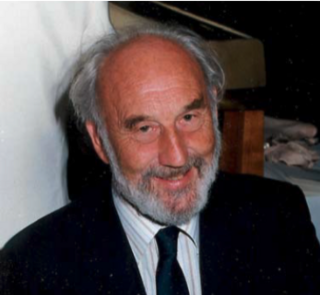Related Research Articles

Caenorhabditis elegans is a free-living transparent nematode about 1 mm in length that lives in temperate soil environments. It is the type species of its genus. The name is a blend of the Greek caeno- (recent), rhabditis (rod-like) and Latin elegans (elegant). In 1900, Maupas initially named it Rhabditides elegans. Osche placed it in the subgenus Caenorhabditis in 1952, and in 1955, Dougherty raised Caenorhabditis to the status of genus.

Howard Robert Horvitz is an American biologist best known for his research on the nematode worm Caenorhabditis elegans, for which he was awarded the 2002 Nobel Prize in Physiology or Medicine, together with Sydney Brenner and John E. Sulston, whose "seminal discoveries concerning the genetic regulation of organ development and programmed cell death" were "important for medical research and have shed new light on the pathogenesis of many diseases".

Sir John Edward Sulston was a British biologist and academic who won the Nobel Prize in Physiology or Medicine for his work on the cell lineage and genome of the worm Caenorhabditis elegans in 2002 with his colleagues Sydney Brenner and Robert Horvitz. He was a leader in human genome research and Chair of the Institute for Science, Ethics and Innovation at the University of Manchester. Sulston was in favour of science in the public interest, such as free public access of scientific information and against the patenting of genes and the privatisation of genetic technologies.
Caenorhabditis briggsae is a small nematode, closely related to Caenorhabditis elegans. The differences between the two species are subtle. The male tail in C. briggsae has a slightly different morphology from C. elegans. Other differences include changes in vulval precursor competence and the placement of the excretory duct opening. C. briggsae is frequently used to study the differences between it and the more intimately understood C. elegans, especially at the DNA and protein sequence level. Several mutant strains of C. briggsae have also been isolated that facilitate genetic analysis of this organism. C. briggsae, like C. elegans, is a hermaphrodite. The genome sequence for C. briggsae was determined in 2003.

Caenorhabditis is a genus of nematodes which live in bacteria-rich environments like compost piles, decaying dead animals and rotting fruit. The name comes from Greek: caeno- ; rhabditis = rod-like. In 1900, Maupas initially named the species Rhabditis elegans, Osche placed it in the subgenus Caenorhabditis in 1952, and in 1955, Dougherty raised Caenorhabditis to the status of genus.
The nematode worm Caenorhabditis elegans was first studied in the laboratory by Victor Nigon and Ellsworth Dougherty in the 1940s, but came to prominence after being adopted by Sydney Brenner in 1963 as a model organism for the study of developmental biology using genetics. In 1974, Brenner published the results of his first genetic screen, which isolated hundreds of mutants with morphological and functional phenotypes, such as being uncoordinated. In the 1980s, John Sulston and co-workers identified the lineage of all 959 cells in the adult hermaphrodite, the first genes were cloned, and the physical map began to be constructed. In 1998, the worm became the first multi-cellular organism to have its genome sequenced. Notable research using C. elegans includes the discoveries of caspases, RNA interference, and microRNAs. Six scientists have won the Nobel prize for their work on C. elegans.
The Rhabditidae are a family of nematodes which includes the model organism Caenorhabditis elegans.

François Émile Maupas was a French librarian, protozoologist, cytologist, and botanist. Maupas contributed to ideas on the life cycle and reproduction of the ciliates. He founded the idea, known as the Maupasian life cycle, that some protists had a definite death following sexual reproduction, contrary to contemporary ideas on protists being immortal. He also identified the existence of mating types in ciliates. He developed culture techniques for a number of organisms and described the nematode Caenorhabditis elegans, which has since become a widely used model organism in biological studies.
Jonathan Alan Hodgkin is a British biochemist, Professor of Genetics at the University of Oxford, and an emeritus fellow of Keble College, Oxford.
OpenWorm is an international open science project to simulate the roundworm Caenorhabditis elegans at the cellular level as a simulation. Although the long-term goal is to model all 959 cells of the C. elegans, the first stage is to model the worm's locomotion by simulating the 302 neurons and 95 muscle cells. This bottom up simulation is being pursued by the OpenWorm community.

Caenorhabditis elegans- microbe interactions are defined as any interaction that encompasses the association with microbes that temporarily or permanently live in or on the nematode C. elegans. The microbes can engage in a commensal, mutualistic or pathogenic interaction with the host. These include bacterial, viral, unicellular eukaryotic, and fungal interactions. In nature C. elegans harbours a diverse set of microbes. In contrast, C. elegans strains that are cultivated in laboratories for research purposes have lost the natural associated microbial communities and are commonly maintained on a single bacterial strain, Escherichia coli OP50. However, E. coli OP50 does not allow for reverse genetic screens because RNAi libraries have only been generated in strain HT115. This limits the ability to study bacterial effects on host phenotypes. The host microbe interactions of C. elegans are closely studied because of their orthologs in humans. Therefore, the better we understand the host interactions of C. elegans the better we can understand the host interactions within the human body.
Caenorhabditis drosophilae is a species of nematodes. It was recovered, along with Rhabditis sonorae, from saguaro cactus rot in Arizona. The species was found on the fly Drosophila nigrospiracula.
Rhabditis is a genus of nematodes in the family Rhabditidae.
Caenorhabditis nigoni is a male-female species in the Elegans group of the genus Caenorhabditis, first identified and described as "Caenorhabditis species 9" or "C. sp. 9" before being renamed as "C. nigoni". The specific epithet is a tribute to Victor Nigon who first studied Caenorhabditis elegans in the laboratory with Ellsworth Dougherty in the 1940s. Isolates come from the Democratic Republic of the Congo and Kerala, India.
Caenorhabditis doughertyi is a species of nematodes in the genus Caenorhabditis. Prior to 2014, it was referred to as C. sp. 10
Ellsworth C. Dougherty was a biologist who was first to study the nematode worm Caenorhabditis elegans in the laboratory, with Victor Nigon, in the 1940s. He did most of his studies and medical work in California.
Oscheius is a genus of nematode.
Protorhabditis is a genus of nematodes in the family Rhabditidae.

Günther Osche was a German evolutionary biologist, ecologist and parasitologist.

Warwick Llewellyn Nicholas (1926-2010) was an Australian zoologist known as a pioneer in the field of nematology. He was a foundational member of the Australian Society for Parasitology (ASP) and in 1964, he organised the first ASP meeting. He became President of the Society in 1978, before being an elected Fellow from 1979.
References
- ↑ Les modalités de la reproduction et le determinisme du sexe chez quelques Nematodes libres. V Nigon - Annales de Sciences Naturelles-Zool. Biol. Anim., 1949
- ↑ Reproductive patterns and attempts at reciprocal crossing of Rhabditis elegans maupas, 1900, and Rhabditis briggsae Dougherty and nigon, 1949 (Nematoda: Rhabditidae). Victor Nigon and Ellsworth C. Dougherty, JEZ-A Ecological and Integrative Physiology, Volume 112, Issue 3, December 1949, Pages 485–503, doi : 10.1002/jez.1401120307
- ↑ History of research on C. elegans and other free-living nematodes as model organisms. Victor Marc Nigon and Marie-Anne Félix at wormbook.org
- ↑ "patents justia".